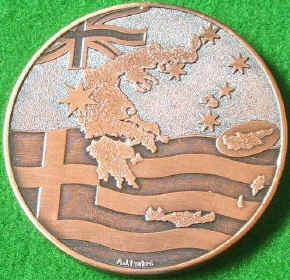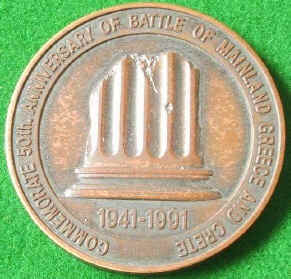 |
|
|||
|
|
||||
|
Italian/German Invasion of Greece |
 |
 |
| A medallion struck to commemorate the 50th Anniversary of the Battle of Mainland Greece and Crete | |
|
On 28 October 1940, Italy invaded Greece from Albania. The intention was a lightning campaign which would lead to the Italian domination of the southern Balkans and the Aegean Sea. The invasion was a failure with the ill-equipped but high-spirited Greek infantry successfully fighting on familiar ground to defeat the more numerous and heavily armed invader. The Italians were forced back into Albania.
Five RAF squadrons were soon operating from Greek airfields against the Italians in Albania and a small infantry group was landed in Crete. General Sir Archibald Wavell, the Middle East Commander-in-Chief went to Athens to offer the Greek dictator, General Metaxas, immediate reinforcements. These were declined on the grounds that they would not effectively reinforce the Greek Army and might provide the Germans with the pretext for attacking Greece. However, it is now known that Hitler had ordered his staff on 12 November 1940 to plan for the occupation of northern Greece, with the objective being enlarged later in the month to include the whole of Greece. Germany's aim was to secure its southern flank in preparation for Operation Barbarossa, the invasion of Russia, timed to begin some time after the 15 May 1941. The German operation, code-named Marita, was to be launched by the 12th Army of 13 divisions attacking northern Yugoslavia and the 2nd Army of 15 divisions attacking southern Yugoslavia and Greece. These forces were supported by air units of the Luftwaffe. On 29 January 1941 General Metaxas died. The new Greek Prime Minister, Alexander Koryzis sent a note to the British Government reaffirming Greece's determination to resist a German attack, repeating that a British force should not be sent to Macedonia unless the German Army entered Bulgaria, but suggesting that the size and composition of the proposed force should be determined. On 24 February at a meeting of British and Greek political and military leaders, British Foreign Secretary, Anthony Eden, said Britain could offer three infantry divisions, the Polish Brigade and an armoured brigade, a total of 100,000 men. By 6 April 1941, the date Germany attacked Yugoslavia and Greece, 50,000 British and Commonwealth troops had arrived in Greece. These forces included the 6th Australian Division commanded by Major General Ivan Mackay, the 2nd New Zealand Division commanded by Major General Sir Bernard Freyberg VC and the British 1st Armoured Brigade. These formations comprised 38 armour, infantry and artillery units, including 16 New Zealand, 14 Australian and 8 British battalions and regiments. The Greek Army consisted of 21 divisions, 15 of which were on the Albania front and 3 on the Metaxas line along the Greek/Bulgarian border in eastern Macedonia and Thrace. The remaining three divisions were part of a joint Greek-British force on the Olympus-Aliakmon line in central Macedonia which stretched from Mount Olympus to the Yugoslav border. On 5 April, General Maitland Wilson formally took command of the forces in central Macedonia with his advanced headquarters at the foot of Mt Olympus on the main Larisa-Florina road. The 1st Australian Corps commanded by General Thomas Blamey was situated from the sea to the Veria Pass. The Greek forces, two divisions called the Central Macedonian Army were in the Vernion mountains, north of Veria. The ill-prepared Yugoslav Army and the Greeks on the Bulgarian border took the shock of the German attack on 6 April. However the Luftwaffe delivered a heavy blow to the British expedition on the night of 6/7 April when German bombers seriously damaged Piraeus, the port of Athens sinking seven merchant ships, sixty lighters and 25 caiques. The port was closed for 2 days and when it reopened, it was with a much reduced capacity to handle the ships needed to reinforce and maintain the British expedition. The Greek forces on the Bulgarian border yielded very little territory in the first three days of fighting but the Germans outflanked the Greek forces by attacking through Yugoslavia down the Axios plain to Salonica. The Greek commander in eastern Macedonia capitulated his isolated army on 9 April. The danger to the Olympus-Aliakmon line was also an outflanking move from Yugoslavia through the Monastir Gap. Wilson decided to create a blocking force in the Florina valley directly under his command. The 1st Armoured Brigade and the 19th Australian Brigade were detached from Blamey's 1st Australian Corps and placed under command of General Mackay. As a result of the German success in eastern Macedonia, the Greek military decided to withdraw from the Albanian front and central Macedonia to a new defence line which would on the east include the Olympus-Aliakmon position but would omit the passes west of the Florina Valley. A rear defensive line from Mt Olympus along the south bank of the Aliakmon River was also planned for a protracted defence. Mackay's force deployed on 9 April at Vevi where the Monastir valley narrows to 100 to 500 yards and followed a winding course through a defile flanked by steep rock-strewn hills with few trees. Next day, German and British guns exchanged fire in the valley and Mackay was ordered to hold until the night of 12 April before withdrawing. Mackay's infantry was commanded by Brigadier Vasey who had 3 battalions spread across ten miles of front much of which was covered with snow; the 2/8th Australian Battalion on the east, the 1st Rangers in the centre and the 2/4th Australian Battalion on the hills to the west. On 12 April the Germans thrust back the Rangers but the Royal Horse Artillery and Australian anti-tank gunners held back German infantry and tanks. By dusk German tanks were among the forward posts of the 2/8th and it was out of touch with Brigade Headquarters. It withdrew but the men reached the vehicles further south and on the west the 2/4th withdrew except for a company which walked into the German lines and was captured. After two successful rearguard actions by the armoured brigade the force was extricated and the infantry reached the Olympus-Aliakmon Line. The 16th Australian Brigade was hurried forward to the Veria Pass on 8 April where it began to take up its positions. The brigade was astride a mountain road some 3000 feet above the sea and troops had to carry their gear, ammunition and rations either by hand or on the backs of donkeys. Snow and rain fell on the mountains and for shelter each platoon had a tent-fly which sagged under the weight of the snow. However, having established itself, the brigade was ordered on 10 April to march back through the snow covered mountains to fill a gap in the New Zealand front west of Servia. With Australian and New Zealand units fighting side by side, Blamey as commander of 1 Australian Corps renamed it the Anzac Corps on 12 April. The following day, Wilson, aware that he would receive no substantial reinforcements from Egypt and concluding that the Greek divisions on his west could not be relied on, informed Blamey that he had decided to withdraw about 100 miles to a shorter line from Thermopylae to the Gulf of Corinth. The order for retirement was issued on 15 April with conduct the withdrawal to be commanded by Blamey. The same day, Wavell and other senior British Middle East commanders met and decided that the evacuation of all forces from the Greek mainland was unavoidable. Blamey's orders for the withdrawal provided that the 6th NZ Brigade would occupy a rearguard position astride the roads near Elasson through which the two forward New Zealand Brigades would withdraw; the 16th Australian Brigade would occupy a position west of Larisa through which the 17th Australian Brigade would withdraw and the 19th Australian Brigade would form a final rearguard at Domokos. Meanwhile German divisions were rushing south and west over muddy cratered roads. Blamey ordered Brigadier Allen's 16th Brigade to the Pinios Gorge to halt the German thrust towards the main road at Larisa, a bottle-neck which was the only escape road for the Anzac Corps. By midnight of 17 April, the Anzac Corps' four forward brigades had west their positions, embussed and driven south, leaving the 6th NZ and the 16th and 17th Australian Brigades astride the 3 main roads converging on Larisa. Throughout daylight on 18 April the Germans attacked the 16th Brigade in the Pinios Gorge and the 6th NZ Brigade at Elasson. The 16th Brigade held the road until late that night but the German tanks forced the two battalion of the 16th brigade into the hills. From the air, the Luftwaffe attacked the long lines of vehicles along the 70 miles escape route to Lamia. Although the air attacks continued all day and were noisy and nerve wracking, the Luftwaffe failed to exploit its superiority and was unable to halt the retreating column and did remarkably little damage to men and vehicles. By dawn on 19 April, all units except parts of battalion in the Pinios Gap were south of Larisa and the Anzac Corps was deploying in the Thermopylae positions. It took the Germans five full days to cover the distance to Thermopylae and prepare for their next attack. On 18 April, Koryzis, the Greek Prime Minister committed suicide and two days later, without authority from Athens, the Greek Army which had fallen back from Albania, surrendered to the Germans. The plans for the evacuation were brought forward and the night of 24/25 April was scheduled for the withdrawal from the Thermopylae line and also for the first large-scale embarkation. The embarkation was from various beaches in the Athens area or in the Peloponnese. To lift the troops there were 6 cruisers, 24 destroyers and escort vessels, 2 Landing Ships Infantry, 14 troopships and a number of landing craft. On 24 April, the Germans attacked the Thermopylae line which was held by the 6th NZ Brigade on the east and the 19th Australian Brigade on the west. German tanks tried to break through the New Zealanders while mountain troops attacked the high pass held by the Australians. The New Zealanders destroyed twelve tanks and together with the Australians held their ground. The 5th NZ Brigade and 6000 corps and base troops embarked on the night of 24/25 April. The 19th Australian Brigade embarked from the Peloponnese beaches the following night. On 26 April, German paratroops cut the only road linking the two parts of the British force. That night troops of the armoured brigade were embarked from Athens beaches and 8000 troops including the 16th and 17th Brigades from Kalamata. The 4th NZ Brigade fought off the Germans on the 27 April and embarked that night but some groups at Kalamata and Navplion were captured. |
